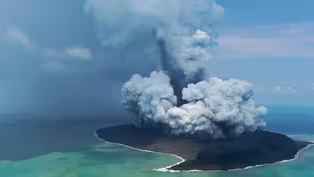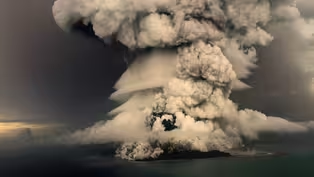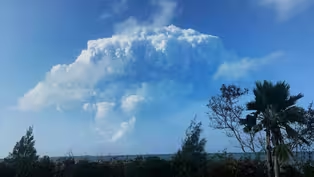
Scientists Make Rare Discovery in Active Volcano
Clip: Season 50 Episode 8 | 2m 58sVideo has Closed Captions
Volcanologists visit Tofua to study the volcano’s activity.
The volcano that produced one the most powerful eruptions in history has a twin, and it’s more active than scientists thought.
Problems playing video? | Closed Captioning Feedback
Problems playing video? | Closed Captioning Feedback
Major funding for NOVA is provided by the NOVA Science Trust, the Corporation for Public Broadcasting , and PBS viewers.

Scientists Make Rare Discovery in Active Volcano
Clip: Season 50 Episode 8 | 2m 58sVideo has Closed Captions
The volcano that produced one the most powerful eruptions in history has a twin, and it’s more active than scientists thought.
Problems playing video? | Closed Captioning Feedback
How to Watch NOVA
NOVA is available to stream on pbs.org and the free PBS App, available on iPhone, Apple TV, Android TV, Android smartphones, Amazon Fire TV, Amazon Fire Tablet, Roku, Samsung Smart TV, and Vizio.
Buy Now

NOVA Labs
NOVA Labs is a free digital platform that engages teens and lifelong learners in games and interactives that foster authentic scientific exploration. Participants take part in real-world investigations by visualizing, analyzing, and playing with the same data that scientists use.Providing Support for PBS.org
Learn Moreabout PBS online sponsorship- [Narrator] Tonga is still recovering from the eruption of the Hunga volcano.
(ominous music) Now scientists have discovered that its volcanic twin, Tofua, is far more active than satellites have led them to believe, a finding that has implications far beyond Tonga.
- [Shane] We had a big eruption around 1,200 years ago, another big one around 800 years ago, and the most recent one around 400 years ago.
(ominous music) - [Narrator] This pattern suggests Tofua should erupt again, and soon.
(ominous music) - [Shane] Okay, this is fantastic.
We've got a bit of a break in the weather.
You can see how blue that gas is coming off that volcano.
(ominous music) When the color of the gas is blue, it's sulfur dioxide.
(ominous music) - [Narrator] This gas is released by the magma.
(ominous music) The blue color is only visible if the levels of sulfur dioxide are high.
- I'm going to try and get a position close to the plume.
I don't want to go underneath it, because sulfur dioxide us actually quite lethal.
We can then try to measure some of the output.
This is what I've been lugging up the hill.
(bag rustling) - [Narrator] Volcanologists monitor the sulfur dioxide to gauge the activity of volcanoes.
- [Shane] This is a telescope.
and it's a rotating one.
- [Narrator] The more sulfur dioxide Shane detects, the more active the volcano.
- Now, it's gonna be scanning over there, and I want it to scan above the level of the opposite caldera rim.
We're capturing it beautifully with this angle.
- [Narrator] Shane's readings indicate the satellites have been dangerously underestimating the levels of sulfur dioxide.
Tofua is releasing far more than previously thought.
Toniella's expert flying reveals that the magma has welled up in the crater, creating a lava lake, one of fewer than 10 on the entire planet, and there's a sign Tofua has been actively throwing out lava incredibly recently.
- This erupted in the last few days.
It's a fresh volcanic bomb, so this really contrasts to all of the rest of the older material around here.
So there's been some quite big explosions to produce these.
It's really interesting, because it looks as if Tofua's entering a new phase of activity, one that we haven't seen here before.
Everything that we've discovered today is absolutely new, and I think will be of quite a shock around the globe.
Video has Closed Captions
Preview: S50 Ep8 | 30s | Investigate one of the most powerful volcanic eruptions in recorded history. (30s)
How an Underwater Volcano Produced a 60-Foot Tsunami
Video has Closed Captions
Clip: S50 Ep8 | 2m 35s | The most explosive event ever recorded on Earth—and the massive tsunami that followed. (2m 35s)
Witnesses Recount Surviving a Volcanic Explosion
Video has Closed Captions
Clip: S50 Ep8 | 2m 57s | Hear witnesses share how they survived the most explosive event ever recorded on Earth. (2m 57s)
Providing Support for PBS.org
Learn Moreabout PBS online sponsorship
- Science and Nature

Capturing the splendor of the natural world, from the African plains to the Antarctic ice.

- Science and Nature

Learn how centuries of knowledge helped our ancestors understand the mysteries of space.












Support for PBS provided by:
Major funding for NOVA is provided by the NOVA Science Trust, the Corporation for Public Broadcasting , and PBS viewers.




